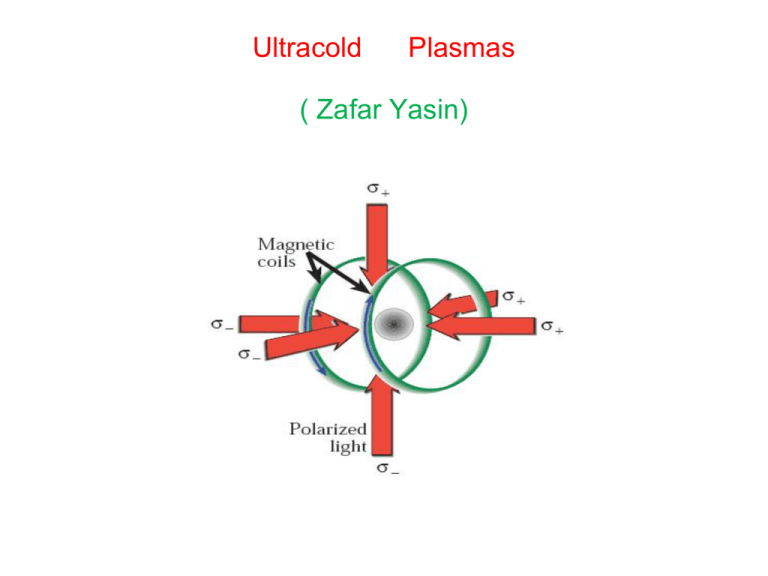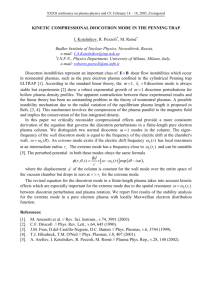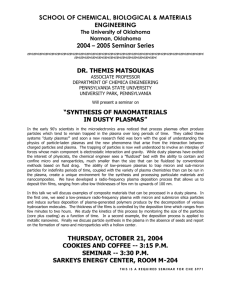Ultracold Plasmas
advertisement

Ultracold Plasmas ( Zafar Yasin) Outline - Creation and why considered important? - Characterization. - Modeling. -My Past Research. - Current Research Trends. Why this topic? - Ultracold Plasmas of astrophysical interest--- so matches with SASS interest. My Plasma Physics Background: - Laser-produced Plasma Theory ---------(1995 QA Univ., Islamabad, Pakistan). - Laser-produced Plasma, and Plasma based accelerators theory, as junior faculty with main task of teaching some undergraduate Physics --------(1995 -1999 KFUPM, Dhahran, Saudi Arabia). - Ultracold Plasma Modeling ---------- (2003, BYU). ( Offcourse now it is SM Physics with BaBar !. Thanks to UCR, I am at SLAC!) Plasma? - Freely moving positively charged ions or nuclei and negatively charged • electrons, for not necessarily completely ionized gas. • - Main Characterising Parameters: • • Long range electromagnetic interactions dominate the short range interatomic or intermolecular forces among large number of particles. Thermal speed: vt = 2 KTe/ me ( Most probable speed in a Maxwellian distribution) Plasma Frequency: Harmonic electron oscillations from equilibrium (homogeneous, unmagnetized plasma). – – pe = ( n0 e2 / 0 me ) ½ pet > 1 , where t is the collision time. (most fundamental time-scale in Plasma Physics). Debye Length: Distance a thermal particle travels during a plasma period. D = (0 KTe/ ne e2 ) 1/2 = ( vt / 2 ) 1/2pe D <<L N D >>1 for to be a plasma, ( ND is number density in a Debye sphere). Degree of Ionization; – From Saha equation for ionized gas in thermal equilibrium; – – – – ni / nn = C T 3/2 /ni e-Ui/ KT , ni / nn >>1 for gas to be a plasma . Ultracold - Doppler Cooling (temperatures from m K to µ K). - Bose Einstein Condensate: (Laser + evaporative) cooling . - Fermionic condensate Atomic clock for precision measurement. Superfluidity. Intense atomic beams. Laser manipulation micron sized particles. Cold atom collisions. Nuclear Physics. Cold molecules. Cavity QED. and - Ultracold Plasmas! Physics Why Ultracold Plasmas are Interesting? - Controllable density and temperatures. - Lab for some exotic Astrophysical Plasmas. - Produce conditions of Laser–produced plasmas. - Challenging Modeling. = (e2 / 4 a po ) / (k Te ) where, a is interparticle spacing. (T.C. Killian et al. / Physics Reports 449 (2007) 77– 130) plot Various Plasmas in density-temperature parameter Ultracold Plasma Creation - Laser cool atoms to slightly above sub-milikelvin temperatures. - Trap the laser-cooled atoms using Magneto Optical trap. - Photoionize , using laser light near the ionization threshold. - Diagnostics with applied electric fields. Schematics of a typical Experiment to create Ultracold (T.C. Killian et al. / Physics Reports 449 (2007) 77– 130) Plasmas What Early Experiments tell? – Non uniform spatial distribution, ~ Gaussian . - Spherically symmetric cloud ~ 200 µ m. - Stablizes to equilibrium after its characteristic thermalization time. - Some electrons leave the system on a time scale given by radius/velocity= 6ns, – for electrons with energy ~ 100K. Some Early Robust Modeling - Shows rapid heating due to three body recombination, which prevents development of strong correlation, producing plasma which is not ultracold, but much colder then 1 eV ( 10,000K). ( S.G.Kuzmin and T.M.O’Neil, Phys.Rev.Lett.88, 65003 ( 2002)) Scaled temperature Vs scaled time - Three body recombination is important at very low temperatures. - Collisions between electrons and Rydberg atoms is source of heating. - Coulomb coupling parameter does not become larger then ~ 1/5. ( F.Robicheaux and James D.Hanson, Phys.rev.Lett.88,55002(2002)) Simulation Results ( from my graduate thesis) - The initial physical conditions and geometry from early experiments . - Spherical symmetry assumed. - Ions treated as static in the background with a Gaussian distribution. - The initial electron density Gaussian. - Number densities ranging from 1014 to 1016 / m3 . - Initial electron temperatures in range from 100K to 1000K. - Cartesian space to model radial expansion. - Total number of electrons considerd = 105. How code works? - Charge density on radial grid is calculated. - Electric field at any point is estimated. - Acceleration calculated, particle is now moved, using leapfrog algorithm - The process is repeated sufficent number of time untill steady state is established.. Temperature Vs Radius during early time ( average local temperature is calculated over small incremental radial lengths) Temperature Vs Radius during later time ( indicating steady state reached) Volume averaged value of temperature plotted against time The net electric field after plasma reaches steady state ( for various temperatures and number densities) Electron density Vs, radius for various initial temperatures and number densities ( dotted lines hows profiles at start of run) • Electron temperature Vs. radius for various initial temperatures and number densities Viscous Electron Fluid Model After dimensional analysis electron fluid equations Scaled Equations Linearization gives following coupled equations for Velocity and Temperature. Subscript 1 denote perturbed part and 0 the equilibrium part. ( These needs to be solved for mode frequencies!) Plots showing the boundary conditions for mode analysis Square of mode frequency Vs. Temperature at number density 1014 / m3 ( Linear behaviour untill 300 K, and then strong damping) Square of mode frequency Vs. Temperature at number density 1015 / m3 ( At very large values of temperature the mode frequency does not vary linearly with T) Square of mode frequency Vs. Temperature at number density 1016 / m3 ( Linear behaviour for temperature greater then 300K) Conclusions Going over last few years of experimental and theoretical research; - Excellent control over lab conditions and diagnostics, is expected to create some of the plasmas of astrophysical interests. - Some of the lab experiments indicate conditions simlar to laser-produced plasmas. - Phase transition between gas, liquid and solid states is expected to be studied in future. - Application of strong magnetic field of several teslas, expect to open a new regime. - Theory work needed to more fully understand how plasma evolve after creation.



